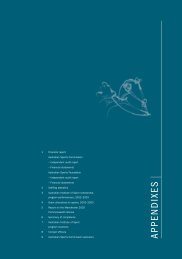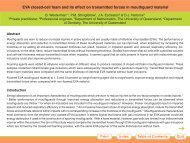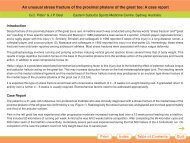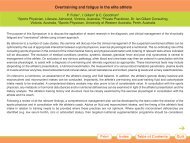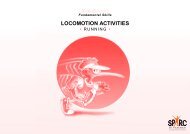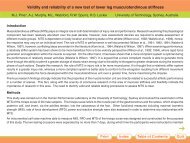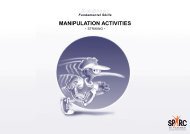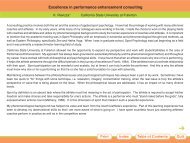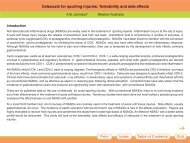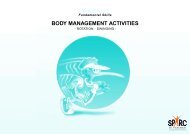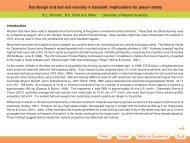EVA mouthguards: How thick should they be? - Australian Sports ...
EVA mouthguards: How thick should they be? - Australian Sports ...
EVA mouthguards: How thick should they be? - Australian Sports ...
You also want an ePaper? Increase the reach of your titles
YUMPU automatically turns print PDFs into web optimized ePapers that Google loves.
Abstract<br />
<strong>EVA</strong> <strong>mouthguards</strong>: <strong>How</strong> <strong>thick</strong> <strong>should</strong> <strong>they</strong> <strong>be</strong>?<br />
B. Westerman 1 , P.M. Stringfellow 2 & J.A. Eccleston 3<br />
1 General practitioner, 2 Professional engineer, 3 Department of Mathematics, The University of Queensland<br />
A major consideration in the performance of <strong>mouthguards</strong> is their ability to absorb energy and reduce transmitted forces when impacted. This<br />
is especially important to participants in contact sports such as hockey or football. The <strong>thick</strong>ness of mouthguard materials is directly related to<br />
energy absorption and inversely related to transmitted forces when impacted. <strong>How</strong>ever, wearer comfort is also an important factor in their use.<br />
Thicker <strong>mouthguards</strong> are not user-friendly.<br />
While <strong>thick</strong>ness of material over incisal edges and cusps of teeth is critical, just how <strong>thick</strong> <strong>should</strong> a mouthguard <strong>be</strong> and especially in these two<br />
areas?<br />
Transmitted forces through different <strong>thick</strong>nesses of the most commonly used mouthguard material, ethylene vinyl acetate (<strong>EVA</strong>), (Shore A<br />
Hardness of 80), were compared when impacted with identical forces which were capable of damaging the oro-facial complex. The constant<br />
impact force used in the tests was produced by a pendulum and had an energy of 4.4 joules and a velocity of 3 meters per second.<br />
Improvements in energy absorption and reductions in transmitted forces were observed with increasing <strong>thick</strong>ness. <strong>How</strong>ever these improvements<br />
lessened when the mouthguard material <strong>thick</strong>ness increased over 4mm.<br />
The results show that the optimal <strong>thick</strong>ness for <strong>EVA</strong> mouthguard material with a Shore A Hardness of 80 is around 4mm and increased<br />
<strong>thick</strong>ness, while improving performance marginally, results in less wearer comfort and acceptance.<br />
Introduction<br />
Mouthguards are used in contact sports to reduce injuries to the oro-facial complex in participants in contact sports. Broken teeth, soft-tissue<br />
injuries, bone fractures and concussion are all reduced in wearers of <strong>mouthguards</strong> when <strong>they</strong> participate in sports which produce impacts<br />
<strong>be</strong>tween players and/or sporting implements. 1-6 <strong>How</strong>ever, economics in its provision can influence the wearer’s choice of a mouthguard. Both<br />
mouth-formed and custom-made types are generally made with ethylene vinyl acetate (<strong>EVA</strong>) which has <strong>be</strong>en shown to have appropriate<br />
physical properties for <strong>mouthguards</strong>.’ 7<br />
Print<br />
Index<br />
Table of Contents<br />
Quit
<strong>EVA</strong> <strong>mouthguards</strong>: <strong>How</strong> <strong>thick</strong> <strong>should</strong> <strong>they</strong> <strong>be</strong>?<br />
B. Westerman 1 , P.M. Stringfellow 2 & J.A. Eccleston 3<br />
1 General practitioner, 2 Professional engineer, 3 Department of Mathematics, The University of Queensland<br />
The performance of <strong>mouthguards</strong> in terms of energy absorption and transmitted forces has <strong>be</strong>en shown to improve with <strong>thick</strong>ness 8,9 or the<br />
inclusion of air-cells. 10 Greater <strong>thick</strong>ness detracts from wearer comfort while air-inclusions increase energy absorption without increasing<br />
<strong>thick</strong>ness. Thicker <strong>mouthguards</strong> reduce the capacity for speech as well as interfering with respiratory efficiency. 11<br />
The <strong>thick</strong>ness of finished <strong>mouthguards</strong> can also <strong>be</strong> influenced by their fabrication. While the <strong>thick</strong>ness of a mouth-formed mouthguard is<br />
influenced by the fabrication to a certain degree, the finished <strong>thick</strong>ness of custom-made <strong>mouthguards</strong> can <strong>be</strong> determined accurately and<br />
modified during fabrication.<br />
The aim of this study was to compare the transmitted forces through various <strong>thick</strong>nesses of the most commonly used <strong>EVA</strong> mouthguard<br />
materials, when impacted with identical forces which are capable of damaging the oro-facial complex.<br />
Materials and Method<br />
• Transmitted forces measured through samples of <strong>EVA</strong><br />
• <strong>EVA</strong> had Shore A Hardness of 80<br />
• Constant impacts produced by impact pendulum<br />
• Test impacts all had energy of 4.4 joules and 3 meters per second velocity<br />
• Flat circular impact head 12.5 mm in diameter<br />
• 20 test impacts on each sample (different site each time)<br />
• Force sensor measured transmitted forces<br />
• Minitab and Microsoft Excel used for statistical analysis<br />
Print<br />
Index<br />
Table of Contents<br />
Quit
Results<br />
<strong>EVA</strong> <strong>mouthguards</strong>: <strong>How</strong> <strong>thick</strong> <strong>should</strong> <strong>they</strong> <strong>be</strong>?<br />
B. Westerman 1 , P.M. Stringfellow 2 & J.A. Eccleston 3<br />
1 General practitioner, 2 Professional engineer, 3 Department of Mathematics, The University of Queensland<br />
Table 1 descri<strong>be</strong>s the mean maximum transmitted forces through the various <strong>thick</strong>nesses of mouthguard material. The greatest transmitted<br />
force was through the 1mm samples but results were not recorded as the force exceeded the performance envelope of the force sensor. This<br />
1mm section material showed little energy absorption and minor reductions in transmitted forces. The greatest recorded transmitted force was<br />
through the 2mm material which transmitted a force of 15.7kN. The smallest transmitted force was through the 6mm material which transmitted<br />
a force of 3.91kN. Figure 1 shows the mean maximum transmitted forces through the materials when measured by the force sensor and are<br />
shown graphically, with time.<br />
Table 1. Mean maximum transmitted forces (kN)<br />
n maximum transmitted forces (kN)<br />
Figure 1. Mean maximum transmitted forces (kN)<br />
Thickness (mm) mean maximum transmitted force (SD)<br />
1 Not recorded<br />
20<br />
2 15.70<br />
15<br />
2 mm<br />
3<br />
4<br />
5<br />
11.40<br />
4.38<br />
4.03<br />
10<br />
5<br />
3 mm<br />
4 mm<br />
5 mm<br />
6 3.91<br />
0<br />
-5<br />
6 mm<br />
transmitted force (kN)<br />
Print<br />
Index<br />
time (0.001 sec)<br />
Increases in mouthguard material <strong>thick</strong>ness from 4mm to 5mm and 6mm showed smaller improvements in energy absorption and transmitted<br />
forces with 8 percent and 10.7 percent less transmitted force, respectively, than the 4mm material. This reduction in transmitted forces was not<br />
statistically significantl in the <strong>thick</strong>er materials. Figure 2 compares the transmitted forces through the materials with different <strong>thick</strong>nesses.<br />
Table of Contents<br />
Quit
Discussion<br />
<strong>EVA</strong> <strong>mouthguards</strong>: <strong>How</strong> <strong>thick</strong> <strong>should</strong> <strong>they</strong> <strong>be</strong>?<br />
B. Westerman 1 , P.M. Stringfellow 2 & J.A. Eccleston 3<br />
1 General practitioner, 2 Professional engineer, 3 Department of Mathematics, The University of Queensland<br />
Figure 2. Mean maximum transmitted forces (kN) and <strong>thick</strong>ness(mm)<br />
transmitted force (kN)<br />
2.00E+01<br />
1.50E+01<br />
1.00E+01<br />
5.00E+00<br />
0.00E+00<br />
<strong>thick</strong>ness (mm)<br />
A commonly asked question by fabricators of <strong>mouthguards</strong> is “ <strong>How</strong> <strong>thick</strong> <strong>should</strong> I make a mouthguard?” This question is more than likely a<br />
response to the realisation that energy absorption and the resulting transmitted forces in <strong>mouthguards</strong> are linked to the <strong>thick</strong>ness of the<br />
material and that wearer acceptance also often dictates the choice of a mouthguard.<br />
Thicker <strong>mouthguards</strong> are often met with wearer resistance <strong>be</strong>cause of discomfort from lip and cheek displacement, speech interference and<br />
also respiratory restrictions.<br />
The practical implication from these data is that when <strong>EVA</strong> material with a Shore A Hardness of 80 is used in mouthguard fabrication, there<br />
appears little advantage in increasing the <strong>thick</strong>ness of material to more than 4mm at any point in the formed mouthguard when transmitted<br />
forces are concerned.<br />
Print<br />
Index<br />
Table of Contents<br />
Quit
<strong>EVA</strong> <strong>mouthguards</strong>: <strong>How</strong> <strong>thick</strong> <strong>should</strong> <strong>they</strong> <strong>be</strong>?<br />
B. Westerman 1 , P.M. Stringfellow 2 & J.A. Eccleston 3<br />
1 General practitioner, 2 Professional engineer, 3 Department of Mathematics, The University of Queensland<br />
While this study has identified cusps and incisal edges as critical areas in terms of energy absorption and transmitted forces, 4mm seems to<br />
represent an ideal <strong>thick</strong>ness that <strong>should</strong> <strong>be</strong> used at any point in the mouthguard which is likely to <strong>be</strong> impacted. This includes the labial flange<br />
of the mouthguard which covers the labial aspects of anterior teeth. It also represents a useful compromise with <strong>thick</strong>ness and wearer comfort.<br />
Conclusions<br />
When <strong>EVA</strong> mouthguard material with a Shore A Hardness of 80 is used in the manufacture of <strong>mouthguards</strong>, optimal energy absorption and<br />
reductions in transmitted force occur when the material is approximately 4mm <strong>thick</strong>. Further increases in <strong>thick</strong>ness do not result in major<br />
improvements in performance.<br />
Acknowledgments<br />
This study was supported by a grant from the <strong>Australian</strong> Dental Research Foundation Inc.<br />
Print<br />
Index<br />
Table of Contents<br />
Quit
References<br />
<strong>EVA</strong> <strong>mouthguards</strong>: <strong>How</strong> <strong>thick</strong> <strong>should</strong> <strong>they</strong> <strong>be</strong>?<br />
B. Westerman 1 , P.M. Stringfellow 2 & J.A. Eccleston 3<br />
1 General practitioner, 2 Professional engineer, 3 Department of Mathematics, The University of Queensland<br />
Gelbier S. The use and construction of mouth and tooth protectors for contact sports. B Dent J 1966;120:533-7<br />
Wood AW. Head protection – cranial,facial and dental in contact sports. Oral Health 1972;62:23-33<br />
Wei SH. Prevention of injuries to anterior teeth. Int Dent J 1974; 24(1):30-49<br />
Garon MW, Merkle A, Wright JT. Mouth protectors and oral trauma: a study of adolescent football players. JADA 1986;12:663-6<br />
Hickey JC, Morris AL, Carlson LD and Seward TE. The relation of mouth protectors to cranial pressure and deformation. JADA 1967;74(3):735-<br />
40<br />
Chapman PJ. The pattern of the use of <strong>mouthguards</strong> in rugby league ( a study of the 1986 <strong>Australian</strong> Rugby League Team). Br J <strong>Sports</strong> Med<br />
1988; 22:98-100<br />
Bishop BM, Davies EH, von Fraunhofer JA. Materials for mouth protectors. J Pros Dent 1985; 53(2): 256-61<br />
Park JB, Shaull KL, Overton B, Donly KJ. Improving mouth guards. J Prosthet Dent 1994;72:373-80<br />
Westerman B, Stringfellow PM, Eccleston JA. Forces transmitted through <strong>EVA</strong> mouthguard materials of different types and <strong>thick</strong>ness. Aust<br />
Dent J 1995;40:389-91<br />
Westerman B, Stringfellow PM, Eccleston JA. An improved mouthguard material. Aust Dent J 1997;42(3):189-91<br />
Francis KT, Brasher J. The physiological effects of wearing <strong>mouthguards</strong>. Brit J of <strong>Sports</strong> Medicine 1991;25(4):227-31<br />
Print<br />
Index<br />
Table of Contents<br />
Quit
<strong>EVA</strong> <strong>mouthguards</strong>: <strong>How</strong> <strong>thick</strong> <strong>should</strong> <strong>they</strong> <strong>be</strong>?<br />
B. Westerman 1, P.M. Stringfellow 2 & J.A. Eccleston 3<br />
1General practitioner<br />
2Professional engineer<br />
3Department of Mathematics, The University of Queensland<br />
ABSTRACT: A major consideration in the performance of <strong>mouthguards</strong> is their ability to absorb energy and<br />
reduce transmitted forces when impacted. This is especially important to participants in contact sports such as<br />
hockey or football. The <strong>thick</strong>ness of mouthguard materials is directly related to energy absorption and inversely<br />
related to transmitted forces when impacted. <strong>How</strong>ever, wearer comfort is also an important factor in their use.<br />
Thicker <strong>mouthguards</strong> are not user-friendly.<br />
While <strong>thick</strong>ness of material over incisal edges and cusps of teeth is critical, just how <strong>thick</strong> <strong>should</strong> a<br />
mouthguard <strong>be</strong> and especially in these two areas?<br />
Transmitted forces through different <strong>thick</strong>nesses of the most commonly used mouthguard material, ethylene<br />
vinyl acetate (<strong>EVA</strong>), (Shore A Hardness of 80), were compared when impacted with identical forces which were<br />
capable of damaging the oro-facial complex. The constant impact force used in the tests was produced by a<br />
pendulum and had an energy of 4.4 joules and a velocity of 3 meters per second.<br />
Improvements in energy absorption and reductions in transmitted forces were observed with increasing<br />
<strong>thick</strong>ness. <strong>How</strong>ever these improvements lessened when the mouthguard material <strong>thick</strong>ness increased over 4mm.<br />
The results show that the optimal <strong>thick</strong>ness for <strong>EVA</strong> mouthguard material with a Shore A Hardness of 80 is<br />
around 4mm and increased <strong>thick</strong>ness, while improving performance marginally, results in less wearer comfort and<br />
acceptance.<br />
INTRODUCTION: Mouthguards are used in contact sports to reduce injuries to the oro-facial complex in<br />
participants in contact sports. Broken teeth, soft-tissue injuries, bone fractures and concussion are all reduced in<br />
wearers of <strong>mouthguards</strong> when <strong>they</strong> participate in sports which produce impacts <strong>be</strong>tween players and/or sporting<br />
implements. 1-6 <strong>How</strong>ever, economics in its provision can influence the wearer’s choice of a mouthguard. Both<br />
mouth-formed and custom-made types are generally made with ethylene vinyl acetate (<strong>EVA</strong>) which has <strong>be</strong>en<br />
shown to have appropriate physical properties for <strong>mouthguards</strong>. 7<br />
The performance of <strong>mouthguards</strong> in terms of energy absorption and transmitted forces has <strong>be</strong>en shown to<br />
improve with <strong>thick</strong>ness 8,9 or the inclusion of air-cells. 10 Greater <strong>thick</strong>ness detracts from wearer comfort while airinclusions<br />
increase energy absorption without increasing <strong>thick</strong>ness. Thicker <strong>mouthguards</strong> reduce the capacity for<br />
speech as well as interfering with respiratory efficiency. 11<br />
The <strong>thick</strong>ness of finished <strong>mouthguards</strong> can also <strong>be</strong> influenced by their fabrication. While the <strong>thick</strong>ness of a<br />
mouth-formed mouthguard is influenced by the fabrication to a certain degree, the finished <strong>thick</strong>ness of custommade<br />
<strong>mouthguards</strong> can <strong>be</strong> determined accurately and modified during fabrication.<br />
The aim of this study was to compare the transmitted forces through various <strong>thick</strong>nesses of the most<br />
commonly used <strong>EVA</strong> mouthguard materials, when impacted with identical forces which are capable of damaging<br />
the oro-facial complex.<br />
MATERIALS AND METHOD:<br />
• Transmitted forces measured through samples of <strong>EVA</strong><br />
• <strong>EVA</strong> had Shore A Hardness of 80<br />
• Constant impacts produced by impact pendulum<br />
• Test impacts all had energy of 4.4 joules and 3 meters per second velocity<br />
• Flat circular impact head 12.5 mm in diameter<br />
• 20 test impacts on each sample (different site each time)<br />
• Force sensor measured transmitted forces<br />
• Minitab and Microsoft Excel used for statistical analysis<br />
RESULTS: Table 1 descri<strong>be</strong>s the mean maximum transmitted forces through the various <strong>thick</strong>nesses of<br />
mouthguard material. The greatest transmitted force was through the 1mm samples but results were not recorded<br />
as the force exceeded the performance envelope of the force sensor. This 1mm section material showed little<br />
energy absorption and minor reductions in transmitted forces. The greatest recorded transmitted force was<br />
through the 2mm material which transmitted a force of 15.7kN. The smallest transmitted force was through the<br />
6mm material which transmitted a force of 3.91kN. Figure 1 shows the mean maximum transmitted forces through<br />
the materials when measured by the force sensor and are shown graphically, with time.
Table 1. Mean maximum transmitted forces (kN)<br />
Thickness (mm) mean maximum transmitted force (SD)<br />
1 Not recorded<br />
2 15.70<br />
3 11.40<br />
4 4.38<br />
5 4.03<br />
6 3.91<br />
Figure 1. Mean maximum transmitted forces (kN)<br />
transmitted force (kN)<br />
20<br />
15<br />
10<br />
5<br />
0<br />
-5<br />
time (0.001 sec)<br />
2 mm<br />
3 mm<br />
4 mm<br />
5 mm<br />
6 mm<br />
Increases in mouthguard material <strong>thick</strong>ness from 4mm to 5mm and 6mm showed smaller improvements in<br />
energy absorption and transmitted forces with 8 percent and 10.7 percent less transmitted force, respectively, than<br />
the 4mm material. This reduction in transmitted forces was not statistically significantl in the <strong>thick</strong>er materials.<br />
Figure 2 compares the transmitted forces through the materials with different <strong>thick</strong>nesses.<br />
Figure 2. Mean maximum transmitted forces (kN) and <strong>thick</strong>ness(mm)<br />
transmitted force (kN)<br />
2.00E+01<br />
1.50E+01<br />
1.00E+01<br />
5.00E+00<br />
0.00E+00<br />
<strong>thick</strong>ness (mm)<br />
DISCUSSION: A commonly asked question by fabricators of <strong>mouthguards</strong> is “ <strong>How</strong> <strong>thick</strong> <strong>should</strong> I make a<br />
mouthguard?” This question is more than likely a response to the realisation that energy absorption and the<br />
resulting transmitted forces in <strong>mouthguards</strong> are linked to the <strong>thick</strong>ness of the material and that wearer acceptance<br />
also often dictates the choice of a mouthguard.<br />
Thicker <strong>mouthguards</strong> are often met with wearer resistance <strong>be</strong>cause of discomfort from lip and cheek<br />
displacement, speech interference and also respiratory restrictions.<br />
The practical implication from these data is that when <strong>EVA</strong> material with a Shore A Hardness of 80 is used in<br />
mouthguard fabrication, there appears little advantage in increasing the <strong>thick</strong>ness of material to more than 4mm at<br />
any point in the formed mouthguard when transmitted forces are concerned.<br />
While this study has identified cusps and incisal edges as critical areas in terms of energy absorption and<br />
transmitted forces, 4mm seems to represent an ideal <strong>thick</strong>ness that <strong>should</strong> <strong>be</strong> used at any point in the mouthguard<br />
which is likely to <strong>be</strong> impacted. This includes the labial flange of the mouthguard which covers the labial aspects of<br />
anterior teeth. It also represents a useful compromise with <strong>thick</strong>ness and wearer comfort.
CONCLUSIONS: When <strong>EVA</strong> mouthguard material with a Shore A Hardness of 80 is used in the manufacture<br />
of <strong>mouthguards</strong>, optimal energy absorption and reductions in transmitted force occur when the material is<br />
approximately 4mm <strong>thick</strong>. Further increases in <strong>thick</strong>ness do not result in major improvements in performance.<br />
ACKNOWLEDGEMENTS: This study was supported by a grant from the <strong>Australian</strong> Dental Research<br />
Foundation Inc.<br />
REFERENCES:<br />
1. Gelbier S. The use and construction of mouth and tooth protectors for contact sports. B Dent J<br />
1966;120:533-7<br />
2. Wood AW. Head protection – cranial,facial and dental in contact sports. Oral Health 1972;62:23-33<br />
3. Wei SH. Prevention of injuries to anterior teeth. Int Dent J 1974; 24(1):30-49<br />
4. Garon MW, Merkle A, Wright JT. Mouth protectors and oral trauma: a study of adolescent football players.<br />
JADA 1986;12:663-6<br />
5. Hickey JC, Morris AL, Carlson LD and Seward TE. The relation of mouth protectors to cranial pressure and<br />
deformation. JADA 1967;74(3):735-40<br />
6. Chapman PJ. The pattern of the use of <strong>mouthguards</strong> in rugby league ( a study of the 1986 <strong>Australian</strong> Rugby<br />
League Team). Br J <strong>Sports</strong> Med 1988; 22:98-100<br />
7. Bishop BM, Davies EH, von Fraunhofer JA. Materials for mouth protectors. J Pros Dent 1985; 53(2): 256-61<br />
8. Park JB, Shaull KL, Overton B, Donly KJ. Improving mouth guards. J Prosthet Dent 1994;72:373-80<br />
9. Westerman B, Stringfellow PM, Eccleston JA. Forces transmitted through <strong>EVA</strong> mouthguard materials of<br />
different types and <strong>thick</strong>ness. Aust Dent J 1995;40:389-91<br />
10. Westerman B, Stringfellow PM, Eccleston JA. An improved mouthguard material. Aust Dent J<br />
1997;42(3):189-91<br />
11. Francis KT, Brasher J. The physiological effects of wearing <strong>mouthguards</strong>. Brit J of <strong>Sports</strong> Medicine<br />
1991;25(4):227-31



